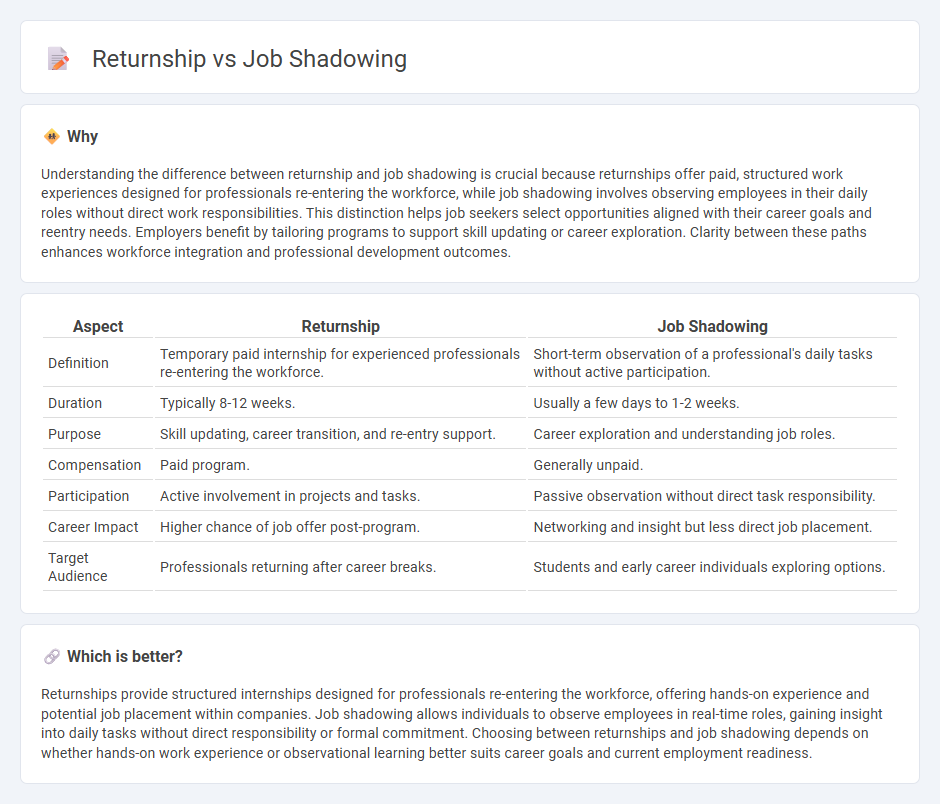
Returnships provide structured work experiences for professionals re-entering the workforce, often with mentorship and skill development opportunities tailored to career transitions. Job shadowing allows individuals to observe employees in real-time, gaining insight into daily tasks and workplace culture without active participation. Explore the benefits and differences to determine which option best supports your career goals.
Why it is important
Understanding the difference between returnship and job shadowing is crucial because returnships offer paid, structured work experiences designed for professionals re-entering the workforce, while job shadowing involves observing employees in their daily roles without direct work responsibilities. This distinction helps job seekers select opportunities aligned with their career goals and reentry needs. Employers benefit by tailoring programs to support skill updating or career exploration. Clarity between these paths enhances workforce integration and professional development outcomes.
Comparison Table
| Aspect | Returnship | Job Shadowing |
|---|---|---|
| Definition | Temporary paid internship for experienced professionals re-entering the workforce. | Short-term observation of a professional's daily tasks without active participation. |
| Duration | Typically 8-12 weeks. | Usually a few days to 1-2 weeks. |
| Purpose | Skill updating, career transition, and re-entry support. | Career exploration and understanding job roles. |
| Compensation | Paid program. | Generally unpaid. |
| Participation | Active involvement in projects and tasks. | Passive observation without direct task responsibility. |
| Career Impact | Higher chance of job offer post-program. | Networking and insight but less direct job placement. |
| Target Audience | Professionals returning after career breaks. | Students and early career individuals exploring options. |
Which is better?
Returnships provide structured internships designed for professionals re-entering the workforce, offering hands-on experience and potential job placement within companies. Job shadowing allows individuals to observe employees in real-time roles, gaining insight into daily tasks without direct responsibility or formal commitment. Choosing between returnships and job shadowing depends on whether hands-on work experience or observational learning better suits career goals and current employment readiness.
Connection
Returnship and job shadowing both provide invaluable pathways for career re-entry and skill development by offering immersive, hands-on experience in a professional setting. Returnships specifically target experienced professionals re-entering the workforce after a hiatus, often incorporating short-term paid assignments with mentorship, while job shadowing allows individuals to observe day-to-day job functions closely, enhancing understanding of specific roles. Together, these programs bridge employment gaps, build confidence, and facilitate networking opportunities crucial for successful reintegration into the labor market.
Key Terms
Observation
Job shadowing offers individuals a direct observational experience by following professionals in their daily tasks, providing real-time insights into specific roles and workplace culture. Returnships focus on reintegrating experienced professionals, allowing them to observe and gradually engage with updated industry practices and organizational dynamics after career breaks. Explore detailed comparisons to understand which approach best suits your career development needs.
Mentorship
Job shadowing offers direct mentorship through observation and guided learning from experienced professionals, helping individuals gain firsthand insights into specific roles. Returnships provide structured mentorship programs designed to support career re-entry, blending hands-on experience with coaching to rebuild skills and confidence. Explore our resources to understand how tailored mentorship enhances job shadowing and returnship opportunities.
Reintegration
Job shadowing offers temporary, observational experiences that allow individuals to understand workplace roles and environments without long-term commitments. Returnships provide structured, paid programs specifically designed for professionals reentering the workforce after an extended absence, focusing on skill redevelopment and career reintegration. Explore more about how each approach supports successful workforce reintegration and the best fit for your career goals.
Source and External Links
Job Shadow - Job shadowing involves observing another employee to learn about their role, often as part of career development or new job training.
What Is Job Shadowing? - Job shadowing provides benefits such as networking opportunities, hands-on training, and insights into career choices for job candidates and students.
How to Start Job Shadowing - This guide offers tips on finding job shadowing opportunities by leveraging networks, social media, and exploring different career paths.
 dowidth.com
dowidth.com